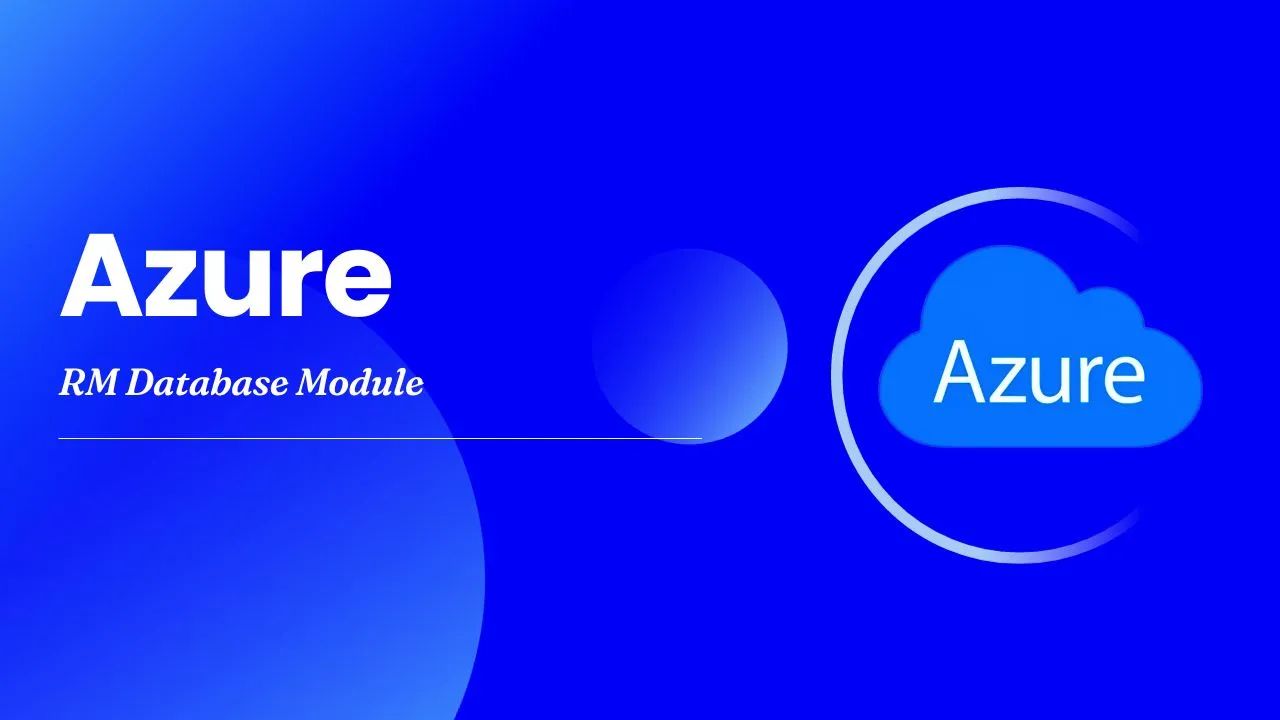Azure RM Database Module
terraform-azurerm-database
Create an Azure SQL Database
This Terraform module creates a basic Azure SQL Database.
Usage
module "sql-database" {
source = "Azure/database/azurerm"
resource_group_name = "myapp"
location = "westus"
db_name = "mydatabase"
sql_admin_username = "mradministrator"
sql_password = "P@ssw0rd12345!"
tags = {
environment = "dev"
costcenter = "it"
}
}
Pre-Commit & Pr-Check & Test
Configurations
We assumed that you have setup service principal's credentials in your environment variables like below:
export ARM_SUBSCRIPTION_ID="<azure_subscription_id>"
export ARM_TENANT_ID="<azure_subscription_tenant_id>"
export ARM_CLIENT_ID="<service_principal_appid>"
export ARM_CLIENT_SECRET="<service_principal_password>"
On Windows Powershell:
$env:ARM_SUBSCRIPTION_ID="<azure_subscription_id>"
$env:ARM_TENANT_ID="<azure_subscription_tenant_id>"
$env:ARM_CLIENT_ID="<service_principal_appid>"
$env:ARM_CLIENT_SECRET="<service_principal_password>"
We provide a docker image to run the pre-commit checks and tests for you: mcr.microsoft.com/azterraform:latest
To run the pre-commit task, we can run the following command:
$ docker run --rm -v $(pwd):/src -w /src mcr.microsoft.com/azterraform:latest make pre-commit
On Windows Powershell:
$ docker run --rm -v ${pwd}:/src -w /src mcr.microsoft.com/azterraform:latest make pre-commit
In pre-commit task, we will:
- Run
terraform fmt -recursivecommand for your Terraform code. - Run
terrafmt fmt -fcommand for markdown files and go code files to ensure that the Terraform code embedded in these files are well formatted. - Run
go mod tidyandgo mod vendorfor test folder to ensure that all the dependencies have been synced. - Run
gofmtfor all go code files. - Run
gofumptfor all go code files. - Run
terraform-docsonREADME.mdfile, then runmarkdown-table-formatterto format markdown tables inREADME.md.
Then we can run the pr-check task to check whether our code meets our pipeline's requirement(We strongly recommend you run the following command before you commit):
$ docker run --rm -v $(pwd):/src -w /src mcr.microsoft.com/azterraform:latest make pr-check
On Windows Powershell:
$ docker run --rm -v ${pwd}:/src -w /src mcr.microsoft.com/azterraform:latest make pr-check
To run the e2e-test, we can run the following command:
docker run --rm -v $(pwd):/src -w /src -e ARM_SUBSCRIPTION_ID -e ARM_TENANT_ID -e ARM_CLIENT_ID -e ARM_CLIENT_SECRET mcr.microsoft.com/azterraform:latest make e2e-test
On Windows Powershell:
docker run --rm -v ${pwd}:/src -w /src -e ARM_SUBSCRIPTION_ID -e ARM_TENANT_ID -e ARM_CLIENT_ID -e ARM_CLIENT_SECRET mcr.microsoft.com/azterraform:latest make e2e-test
Prerequisites
Requirements
Providers
| Name | Version |
|---|---|
| azurerm | ~>3.0 |
Modules
No modules.
Resources
| Name | Type |
|---|---|
| azurerm_resource_group.rg | resource |
| azurerm_sql_active_directory_administrator.aad_admin | resource |
| azurerm_sql_database.db | resource |
| azurerm_sql_firewall_rule.fw | resource |
| azurerm_sql_server.server | resource |
Inputs
| Name | Description | Type | Default | Required |
|---|---|---|---|---|
| collation | The collation for the database. Default is SQL_Latin1_General_CP1_CI_AS | string | "SQL_Latin1_General_CP1_CI_AS" | no |
| create_resource_group | Create a new resource group with name var.resource_group_name, or just use it as resource group's name. Default to true. Changing this forces a new resource to be created. | bool | true | no |
| db_edition | The edition of the database to be created. | string | "Basic" | no |
| db_name | The name of the database to be created. | string | n/a | yes |
| end_ip_address | Defines the end IP address used in your database firewall rule. | string | "0.0.0.0" | no |
| location | The location/region where the database and server are created. Changing this forces a new resource to be created. | string | n/a | yes |
| resource_group_name | Default resource group name that the database will be created in. | string | "myapp-rg" | no |
| server_version | The version for the database server. Valid values are: 2.0 (for v11 server) and 12.0 (for v12 server). | string | "12.0" | no |
| service_objective_name | The performance level for the database. For the list of acceptable values, see https://docs.microsoft.com/en-gb/azure/sql-database/sql-database-service-tiers. Default is Basic. | string | "Basic" | no |
| sql_aad_administrator | object({ login = (Required) The login name of the principal to set as the server administrator object_id = (Required) The ID of the principal to set as the server administrator tenant_id = (Required) The Azure Tenant ID azuread_authentication_only = (Optional) Specifies whether only AD Users and administrators can be used to login ( true) or also local database users (false).}) | object({ login = string object_id = string tenant_id = string azuread_authentication_only = optional(bool) }) | null | no |
| sql_admin_username | The administrator username of the SQL Server. | string | n/a | yes |
| sql_password | The administrator password of the SQL Server. | string | n/a | yes |
| start_ip_address | Defines the start IP address used in your database firewall rule. | string | "0.0.0.0" | no |
| tags | The tags to associate with your network and subnets. | map(string) | { "tag1": "", "tag2": "" } | no |
| tracing_tags_enabled | Whether enable tracing tags that generated by BridgeCrew Yor. | bool | false | no |
| tracing_tags_prefix | Default prefix for generated tracing tags | string | "avm_" | no |
Outputs
| Name | Description |
|---|---|
| connection_string | Connection string for the Azure SQL Database created. |
| database_name | Database name of the Azure SQL Database created. |
| sql_server_fqdn | Fully Qualified Domain Name (FQDN) of the Azure SQL Database created. |
| sql_server_location | Location of the Azure SQL Database created. |
| sql_server_name | Server name of the Azure SQL Database created. |
| sql_server_version | Version the Azure SQL Database created. |
Download Details:
Author: Azure
Official Github: https://github.com/Azure/terraform-azurerm-database
License: MIT
#azure #Microsoft #database
